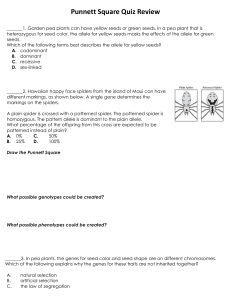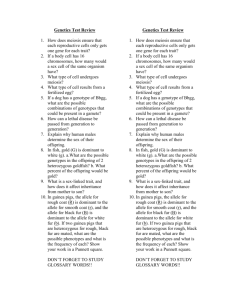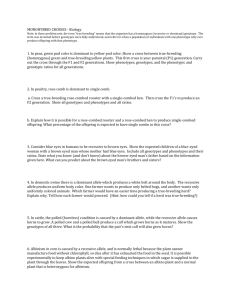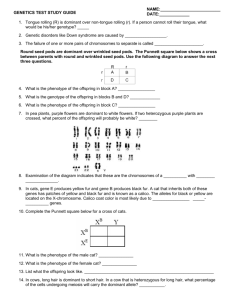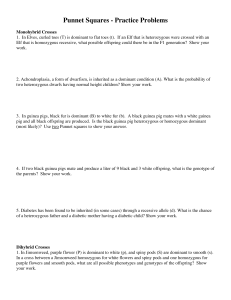Questions for final exam Fall 2009
advertisement
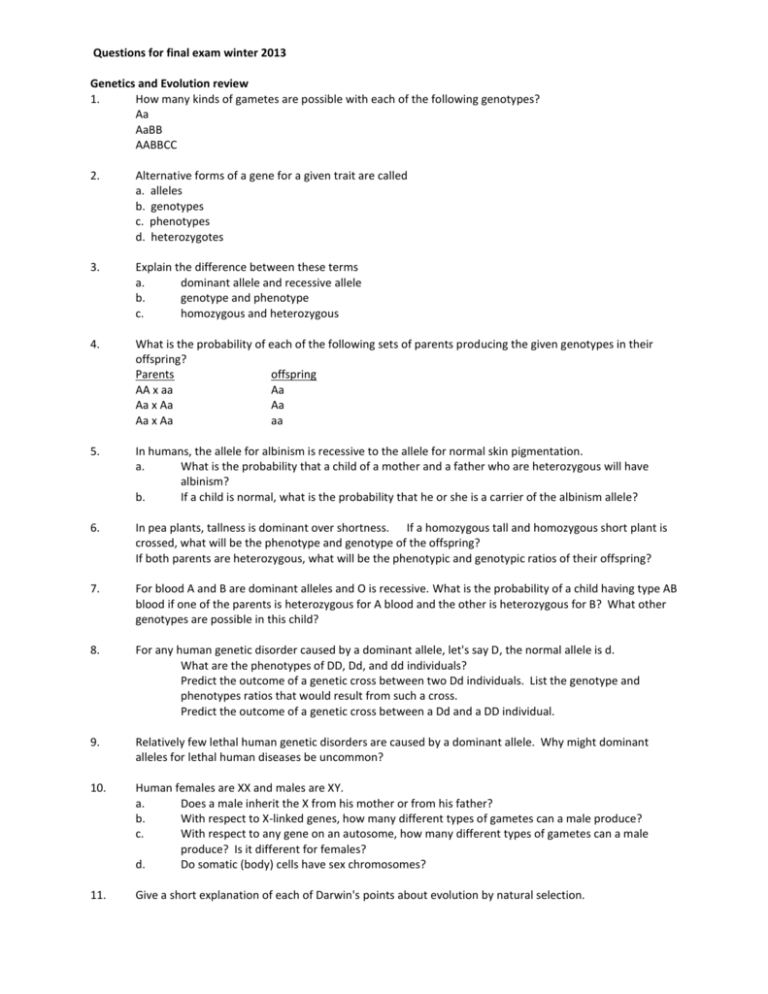
Questions for final exam winter 2013 Genetics and Evolution review 1. How many kinds of gametes are possible with each of the following genotypes? Aa AaBB AABBCC 2. Alternative forms of a gene for a given trait are called a. alleles b. genotypes c. phenotypes d. heterozygotes 3. Explain the difference between these terms a. dominant allele and recessive allele b. genotype and phenotype c. homozygous and heterozygous 4. What is the probability of each of the following sets of parents producing the given genotypes in their offspring? Parents offspring AA x aa Aa Aa x Aa Aa Aa x Aa aa 5. In humans, the allele for albinism is recessive to the allele for normal skin pigmentation. a. What is the probability that a child of a mother and a father who are heterozygous will have albinism? b. If a child is normal, what is the probability that he or she is a carrier of the albinism allele? 6. In pea plants, tallness is dominant over shortness. If a homozygous tall and homozygous short plant is crossed, what will be the phenotype and genotype of the offspring? If both parents are heterozygous, what will be the phenotypic and genotypic ratios of their offspring? 7. For blood A and B are dominant alleles and O is recessive. What is the probability of a child having type AB blood if one of the parents is heterozygous for A blood and the other is heterozygous for B? What other genotypes are possible in this child? 8. For any human genetic disorder caused by a dominant allele, let's say D, the normal allele is d. What are the phenotypes of DD, Dd, and dd individuals? Predict the outcome of a genetic cross between two Dd individuals. List the genotype and phenotypes ratios that would result from such a cross. Predict the outcome of a genetic cross between a Dd and a DD individual. 9. Relatively few lethal human genetic disorders are caused by a dominant allele. Why might dominant alleles for lethal human diseases be uncommon? 10. Human females are XX and males are XY. a. Does a male inherit the X from his mother or from his father? b. With respect to X-linked genes, how many different types of gametes can a male produce? c. With respect to any gene on an autosome, how many different types of gametes can a male produce? Is it different for females? d. Do somatic (body) cells have sex chromosomes? 11. Give a short explanation of each of Darwin's points about evolution by natural selection. Review of previous topics – questions on the final exam will be drawn from these questions. 1. 2. 3. 4. 5. 6. 7. 8. 9. 10. 11. 12. 13. 14. 15. 16. 17. Arrange these 6 levels of life's organization from smallest to largest: Cell, molecule, organelle, multicellular organism, ecosystem, population. Be able to describe and give an example of each. Review the concepts we've covered including chemicals important to life, cell structure, different types of cell division, genes, and ecosystem relationships between different species. How do a habitat and niche differ? Describe your habitat and niche. Why isn't life distributed evenly across the planet? Why is a food web more accurate than a food chain as a description of predator-prey relationships in an ecosystem? Compare trophic levels for a vegetarian and a person who eats meat. What is the relationship between global warming and the greenhouse effect? Your cells have supplies of dissolved simple sugars, fatty acids, amino acids, and nucleotides all of which are small organic compounds. a. Know which monomers are the building block for which large biological molecules found in cell structures? b. For each large biological molecule, name an example (e.g., glycogen) and describe its function. c. A topping for ice cream contains fructose, hydrogenated soybean oil, salt and cellulose. What types of chemicals are in it? Which are organic and which are inorganic? Describe 3 features that all cells have in common. Describe the key differences between prokaryotic and eukaryotic cells. DO NOT use shape as one of your differences. Why are some substances able to cross a cell membrane easily and some are not? Define diffusion. Define osmosis. What are their roles in life? Define active transport. Include examples. What is the key difference between the outcomes of sexual and asexual reproduction? Explain the difference between these terms a. chromatid and chromosome b. prokaryote and eukaryote What are the functions of these organelles and cell structures: chromosomes, mitochondria, ribosomes, chloroplasts, lysosomes, cell plasma membrane? What are key differences between active transport and diffusion? What is the relationship between genes and chromosomes? How can you explain the occurrence of birth defects (caused by altered genes) in children and grandchildren of victims of atomic bombs in Hiroshima and Nagasaki when the victims themselves were only mildly affected? If an organism were genetically cloned, would its experience of life also be a clone of the first organism? What other factors may be influential, other than genetic makeup?

